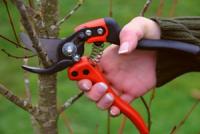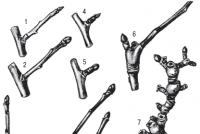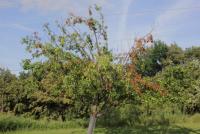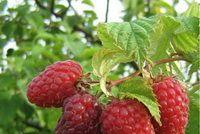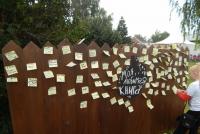Questions about caring for an apple tree. Apple-Book Festival "Antonov apples
How many years does the apple tree live?
In principle, an apple tree can grow and bear fruit for up to 100 years and even more. Known apple long-livers living in this world for 300 years. But in the North-West, apple trees begin to die, mainly because of the death of the bark, at a young age - 20-25 years.
How to choose a place on the site for planting an apple tree?
First of all, it is necessary to choose a place on the site so that the trees are covered from the north winds. It is better if there are other plants along the northern border, for example, spruce, maples (naturally, outside the boundaries of your site), shadberry, red rowan, sea buckthorn. In the south, in front of the house, you can plant a couple of fruit trees, but the whole garden should not be planted, because in ten years in front of the house there will be a solid shadow in which only grass will grow well. And we have small plots, and we should not squander the precious area under the sun. Apple trees can be placed in 1-2 rows along one of the borders of the site (only not from the south!), Departing from the border of the neighbor's site, as expected, 3-4 meters. To prevent these precious meters from disappearing, plant berry bushes between the trees and the border . For example, you can plant a raspberry (which is very friendly with an apple tree, besides it can bear fruit in partial shade) or black currant (which can also bear fruit in partial shade), leaving 1–1.5 m to the border, so that it is convenient to work with berries. crossing the border. The root system of raspberry and black currant is located in the surface layer of the soil, and the root system of the apple tree is lower, so there will be no competition for moisture and nutrition between these berry bushes and trees. Trees are planted at a distance of 4 m from each other, and shrubs - 1-1.5 m.
If you have more land, you can plant trees in one group in two places, according to the 4 × 4 m scheme. Then it is not necessary to make straight paths - make them winding, flowing around the planting groups. Visually, such a free garden composition with winding paths increases the space of the garden, but there are much less plants in the same area as with a regular layout.
I have clay soil on the plot. Is it possible to plant apple trees, will they die?
Do not die if you do everything right. If clay or heavy loam is in the area, then trees cannot be planted in the pits. Clay does not let the water through, during the autumn rains the landing pit will fill with water. In winter, it will freeze through, which, of course, will cause the death of the root system. It is impossible to plant in pits and on peat bogs, as well as where groundwater lies close (less than 1 m). In all these cases, hills should be filled with a height of about 60-80 cm and a diameter of at least 1 m. In subsequent years, the hill should be expanded. To do this, it is enough to pour a compost pile around it, and in order to have a neat look at the perimeter of the tree, pour peat or sand over garbage and weeds each time. If you use peat, remember that it acidifies the soil under the apple tree, and she prefers neutral soil, therefore it is necessary to add ash to the peat at the rate of 1 half liter jar for each bucket of peat (either 1 cup of lime or dolomite). Where to take as much land for the bulk hill? And you just put trash right under the future hill right on the ground.
First, lay a layer of stones, broken slate or red bricks to keep the roots from growing down, where they will die. Overlaid all this with any land that you will be able to heat up on your own plot and near it. Then fold the torn, old books (this is, of course, barbarism, but agree that many of the books produced by this book are only fate and worthy), magazines, pieces of old boards, large branches, chips, cardboard, unnecessary things made of cotton or wool (synthetics do not rot, but only litter the soil, so it should not be put). And again all this is stratified by earth. Then bring crumpled black and white newspapers (a small amount of colored material is permissible, but color glossy illustrations are not, due to the presence of a large number of harmful dyes in them). Deoxidizers should be added to this layer: ash, dolomite, lime, whatever you have, at the rate of 1 cup of lime or dolomite for each bucket of earth, or 1 half liter can of ash. Then all summer, you can put a compost pile on this place, sprinkling weeds and food waste, as well as feces from the toilet with soil, sand or peat. From time to time add a handful of superphosphate. If you want, you can water the compost pile with a solution of “Baikal Em 1”, “Renaissance” or “Compostina” or add “Shine”. These preparations will accelerate compost rework. By next spring, the heap will settle by two thirds of the height, so in the fall its height should be at least 1.2 m. In the spring, before planting, pour a heap of potassium solution that does not contain chlorine, namely: 3 tablespoons of potassium sulfate or carbonate (and Better potassium nitrate) to 10 liters of water. In the fall, potassium makes no sense, because during the autumn rains and winter thaws, water will dissolve and wash it in the lower layers. From above, add the usual ground, which you have, in a layer of about 40 cm.
If the site is very close groundwater, then how to properly plant an apple tree?
At close standing of groundwater, as well as on peaty marshy soil, the growth of the central root deep down should not be allowed. It is necessary to force it to branch so that the root system is located in the horizontal upper layer of the soil. On clay it happens, but in other cases (except for planting on sandy soils), it is necessary to immediately impede the growth of roots. To do this, pour a layer of stones, broken bricks, clay shards, pieces of slate on the bottom of the seat, and only then bring in the soil. This is especially true for pears in the North-West, because pears have a tap root system and central root to a depth of 4 m, and the pear does not tolerate over-wetting of the soil, especially stagnant or groundwater.
How to plant an apple tree, if on the site the usual soil?
If you have the usual soil (sandy loam or light loam, and even more so, arable land), then you can generally plant on a flat surface. It is only necessary to remove the top layer of soil. Turn the turf and lay it around the seat, creating a frame. Pull out the roots and rhizomes of perennial weeds. Make a small depression (15-20 cm), fold the ground out onto the frame. Place a mound of fertile, moist soil in the center of the depression and plant a seedling on this mound. Sprinkle on top of good soil, flush with the frame.
Before planting, any seedling should be put in the water for 2-3 hours so that the tree is saturated with moisture, and then immediately planted into place. But do not hold water for more than 2-3 hours: the roots will lose a significant part of potassium, and this will have a bad effect on their survival and further growth.
How to plant an apple tree to the stakes when planting?
After planting, the seedling should be tied up, otherwise the wind will loose the root system in loose soil and the seedling will simply fall. But how exactly to tie? Of course, did you pay attention to how the saplings are tied when planting the city? Here and tie - to the three stakes. This is the most reliable way. And if you are accustomed to tying to two, then drive the stakes not from the south and north of the seedling, as recommended in the books (explanations on this score are unintelligible), but drive the stakes in the direction of the winds prevailing in your area. In the North-West westerly winds prevail, which means that the stakes need to be driven from the west and east of the seedling. Then the harness will keep the seedling from swinging by the wind. If you plant a one-year old twig or plant a plant grown in a container, you do not need to tie it up.
They planted an apple tree, it settled down, dismissed the leaves, and then suddenly dried up. Why?
If the apple tree dried up, despite the abundant watering, then most likely you made a mistake when planting. It was necessary to cut the aboveground part of the plant, that is, to shorten the central conductor and all branches by a quarter (and even a third in a dry time) of their length. Then the balance between the weakened root system and the above-ground part too large for it will be restored and the seedling will take root well. This, of course, does not apply to seedlings grown in a container.
Is it necessary in the autumn to rake the leaves under the apple trees?
In the North-West, tree roots spread quite far beyond the perimeter of the crown, since the roots do not go deep into cold and barren soils, but prefer to spread out wide, in a small arable layer of soil only 40-50 cm thick, and therefore vulnerable to large sudden frosts after thaw. Therefore, I recommend not to rake leaves in autumn, but, on the contrary, to throw them around the trees. Allegedly, wintering on the leaves of pests and pathogens, do not be afraid, there are no more and no less of them than with spring and autumn digging of tree trunks. This is also, by the way, a delusion. The less you dig, the better the tree will bear fruit.
Why does an apple tree not bear fruit for a long time?
Winter varieties of apple trees generally begin to bear fruit much later than autumn and, especially, summer varieties.
This can occur even in the seventh year after planting a one-year-old or two-year-old seedling. But if all the deadlines have passed, and the apple tree does not want to bear fruit, check whether you have deepened the trunk too much when planting. The tree in this case will have to pick up or dig. When planting apple trees, the root collar is not buried at all in the soil, let it be better to be slightly above the soil surface. Another reason may be that the branches grow vertically or almost vertically upwards. They must be bent to an almost horizontal position. Only on the horizontal branches and is fruiting. The branches should be bent down gradually, for this they make a cuff of dense material, which freely embraces the branch. Then, over the cuff, without tightening it, tie a rope. The end of the rope is tied to a peg driven into the soil from the side where they are going to deflect the branch. (The peg is driven in obliquely from the tree.) After that, they begin to gradually wind the rope on the stake. By slightly bending the branch over the summer, it is allowed to winter in this position, and the next summer it is bent back to an almost horizontal position. If the branches are located horizontally and the planting is done correctly, and the apple tree does not bear fruit, this is caused by a lack of iron. There is an old folk remedy: drive into the trunk of an apple tree two medium-sized rusty nails. And you can just bury some rusty metal objects under the apple tree or spray it with a 0.1% solution of ferrous sulfate 2-3 times during the season (1 teaspoon of vitriol per 8-10 liters of water). Or use "Uniflor-micro" or "Florist" (2 teaspoons per 10 liters of water) for foliar feeding.
When to plant an apple tree?
Generally speaking, in the spring. In the Northwest, the best landing time is May. The apple tree is a sonul, it wakes up relatively late, late turns the leaves, the root system starts working only when the soil in the zone of sucking roots warms up to 8 ° C. In the North-West soils are poor in humus, so they are cold. They warm up slowly due to the fact that cold comes from the lower layers of the earth, and the above-ground temperature is low, that is why the upper layer also warms up slowly. In such conditions, a half-awake apple tree easily tolerates transportation and transfer in May.
What to look for when buying apple seedlings?
Be sure to carefully inspect the roots. If they are too dry and there are no young roots on them, do not take seedlings. There will be little sense from him. Therefore, it is better not to buy seedlings at all exhibitions and fairs there, because planting material is usually imported, and from the southern regions of the country. First, imported varieties are not regionalized for other regions, grown in the southern regions, with a warmer climate than where they are to live, so they will often freeze, and in the harsh winter they may even die. In addition, the seedlings were carried for a long time, and therefore their root system can be in a deplorable state. It is best to go to a well-established local nursery, and there, on the spot, buy a seedling. Still very good if it is dug right in front of you.
How to transport an apple tree seedling?
It will be great if, going for apple seedlings, you bring with you sphagnum moss. Moss retains moisture and, moreover, bactericidal, so the roots, lined with such moss, will easily carry the shipment. But not everyone can get moss, there is another option: it is enough to wrap the roots with wet newspapers in several layers. Then you need to wrap them in a plastic diaper, and then you can even carry 2-3 days. Previously, before being transported long distances, the roots of seedlings were dipped in a clay talker with a mullein. This was done in order to preserve small sucking roots. If they are alive, the apple tree will quickly take root.
Can I plant a three year old apple tree?
Apple trees older than three years to plant does not make any sense. In general, the younger the sapling, the easier it takes root in a new place. Therefore, I recommend buying annual saplings, they are also cheaper.
We have bought apple seedlings, and the place for planting is not yet ready. Where to put the seedlings?
If you bought an annual sapling grown not in a container, but you didn’t prepare a seat for it, then plant it on any vegetable patch. Let the first year grow up, and during this time you will prepare a permanent place for it and transplant it to the place next spring. You can dig up a seedling in the spring and plant it again in the same place until the next spring. Such a triple planting transplant makes the plant relive stress, and they help strengthen the tree. He will have large, good quality apples. Sometimes even a wilderness grown from the seeds of a ripe apple (of course a zoned variety), transplanted three times, produces remarkably large, tasty fruits.
What conditions does an apple tree need for normal growth and fruiting?
Like most plants, the apple tree prefers a soil with a neutral, at least with slightly acidic, reaction rich in organic matter and potassium. This is a pot plant, do not forget about it! But the apple tree will grow and even bear fruit on clay or peat bog, on sandy and stony soil, rather scarce. In principle, the plant is rather moisture-loving, but with small droughts it is quite tolerant. It suffers quite large frosts, and therefore managed to settle down in rather severe northern latitudes. An apple tree needs a good place under the sun. She, of course, will reconcile with the penumbra, but in such a wet region as the North-West, where there is little light, in the penumbra the lichen will quickly begin to overcome the apple tree.
Do I need to make when planting seedlings fertilizer?
It all depends on what kind of soil you have at the landing site. If it is good, garden land, then do not. If solid sand, then it is necessary to make any complex mineral fertilizer, slowly dissolving in water. For an annual sapling, it is quite sufficient to add, for example, 1 tablespoon of Akvarin from the Buysky Chemical Plant. Or 1 tablespoonful of granulated, water insoluble AVA fertilizer. It, by the way, will be enough for three years. At worst, you can make 1 tablespoon of "Azofoski", even better - "Ecofoski" or "Kemira". In addition, you need to make organic. In sandy or sandy or podzolic soils - 2-3 buckets of rotted compost or manure for one year old seedling. Under the two-year seedling dose should be doubled, and under the three-year - three times. If the soil is peaty, then it is better to deoxidize it, and not to make mineral fertilizers. Organics on such soils in the first year of life of the seedling is also not needed. In clay, as mentioned above, trees are not planted, but the hill, which will have to be poured over it, must contain both organic and mineral fertilizers.
How many times in a season do you need to feed an apple tree?
Unlike garden plants, which should be fed and watered throughout the season, an apple tree needs mineral dressing twice a season. The first must be done in the spring, at the moment of leaf turning. Plants need at this time nitrogen and potassium. You can use specialized dressings for fruit plants of the Buysky chemical plant, you can only use "Akvarin" or "Omu". Enough 3 tablespoons per 10 liters of water. Or take the "Ecofosku" or "Kemira". At worst, use 1 tablespoon of urea and 2 tablespoons of potassium carbonate or sulphate (or potassium magnesium) per 10 liters of water. The second mineral dressing is needed for fruit and berry crops at the end of summer, when the young root system begins to build up in them. In mid-late August, prepare a solution of double granular superphosphate (2 tablespoons) and potassium (1 tablespoon) that does not contain chlorine in 10 liters of water. And pour this solution at the rate of 10 liters per square meter (of course, around the perimeter of the crown of the plant). Do not worry that superphosphate does not dissolve in cold water. Gradually it will penetrate the root zone and even remain in the soil for the next season. But you can use ready-made autumn fertilizer for fruit and berry plants of the Buysky plant. And if once in 2-3 years you put the compost around the perimeter of the crown of one or the other of an apple tree, then no additional feeding of the tree will be needed, with the exception of trace elements.
How to feed an apple tree with AVA fertilizer?
Once every three years, you will embed 3 tablespoons of AVA granulated complex fertilizer into the soil at a depth of 7-10 cm along the perimeter of the apple crown. To do this, just a corner pololnik draw a groove around the apple. Spread the fertilizer evenly and sprinkle it with soil. This fertilizer does not dissolve in water, and therefore is not washed out of the soil. The plant spends it sparingly and evenly throughout the season. Fertilizer is dissolved in organic soil acids (partly the roots themselves secrete these acids, dissolving the fertilizer as needed). It is only necessary to remember that in alkaline media, fertilizer does not work, therefore, ash, dolomite, lime and other deoxidizing agents should not be applied simultaneously with it.
What is a shaped apple tree?
Apple trees with an artificially created crown shape are usually called molded. An apple tree is a very plastic plant (which cannot be said about a pear), and therefore it easily tolerates pruning, and the crown of an apple tree can be given a pruning of the most diverse shape.
How to check whether the apple tree froze after a hard frost?
It is necessary to cut off the end of the branch and look at the cut. Apple has a living tissue of white, and the degree of freezing of wood is determined by the degree of darkening. Light brown or dark beige indicates that the wood has died. But the death of the ends of the branches does not confirm the death of the tree. Ends in general could not mature or the tree went to winter dehydrated (during prolonged dry autumn weather), that frost and dried up the ends of the branches. So the cut must be done on the cortex of the trunk. And immediately cover the wound with brilliant green and liquid garden pitch or natural oil paint. If the cambium (a narrow green conductive layer between wood and bark) is alive, it is green, and if dead, then brown. In this case, the tree really died.
How to protect the tree from frostbite?
The easiest way is whitewashing. But it is used when the trees are more than three years old. It is better to wrap young trees with synthetic material (nylon tights, synthetic sacking made from sugar or cereals, lutrasil or spanbond). However, lutrasil and spunbond do not protect against rodents. Do not wrap the stems with ruberoid or other dark material. In the spring, it quickly heats up in the sun, and the cambium awakens during the day, and at night a strong cooling stops this process. Cambium from such changes in day and night temperatures may die, and this will lead to peeling of the bark. In order to help the plants easier to transfer frosts and other weather problems, use "Ecoberin", or "Epin-extra", or "Novosil" ("Silk"). "Ekoberin" protects plants from various weather troubles (droughts, frosts, sudden changes in temperature during the day and at night, prolonged cooling). In addition, it helps plants adapt to strong ultraviolet radiation. “Epin-extra” practically does the same, besides, it contributes to self-defense of plants against diseases. Novosil also enhances plant self-defense against pests and diseases, but also removes the stresses caused by adverse weather conditions, which allows plants, in particular, to more easily tolerate frosts.
The leaves of the apple tree are coiled up and turned brown on the edges. What is this disease?
This is not a disease, but a shortage of apple potassium. Help is needed. Sprinkle the plant with Uniflor Bud (2 teaspoons per 10 liters of water) or a weak solution of potash fertilizer (1 tablespoon per 10 liters of water).
The foliage of the apple tree somehow brightened and became shallow. Why?
This can happen with a lack of nitrogen. Feed any nitrogen fertilizer (1 tablespoon per 10 liters), preferably together with potassium (potassium nitrate, for example). Or use "Uniflor-growth".
Apple leaves have acquired a marble color. What to do?
Most likely, the lack of magnesium affects, in this case the leaves become marble in color - dark green with light green. The leaves should be sprayed with English salt or a solution of potassium magnesia (1 tablespoon per 10 liters of water). If marble spotting is variegated (yellow-green or red-green and so on), then most often this indicates a lack of some trace element. The easiest way to spray "Uniflor-micro" (2 teaspoons per 10 liters). Instead of "Uniflora" you can use "Florist" or "Aquadon micro" in the same concentration.
Why does a seemingly clean apple have a whole brown heart?
The cause may be fusarium rot or simply a lack of trace elements in the soil (this is a frequent occurrence on poor soils, in particular, in the North-West). With a lack of trace elements should be sprinkled with an apple tree or "Florist", or "Aquadone micro" or "Uniflorom-micro." This should be done at the time of formation of the ovaries. Fruits with a lack of trace elements are quite edible. If it is rotten, the fruits are inedible, they have a bitter taste. The disease is most often manifested during storage. Sometimes an apple starts to rot right on the tree. In this case, it would be nice to spray the tree with the drug "Zircon" or "Novosil" ("Silk") in order to prevent the transfer of fruit rot to healthy fruits. Take away the storage of whole fruits that are collected without bruises. It is good to spray them before storing them with “Fitosporin”, then dry them and only then put them in boxes, sandwiching them with dry straw or wrapping each apple in a piece of newspaper.
Why does the apple pulp sometimes have a “glassy” look?
The vitreousness of the fruit appears either when the fruit froze right on the trees with small early autumn frosts (this usually happens with late varieties that did not have time to ripen), or during prolonged rainy weather before harvesting (due to too much water in the apple sap). Appears usually during storage. These apples are stored poorly, the taste of the fruit fall.
Why do apple trees exfoliate bark?
The most common primary cause is either cold bones or sunburn of the cortex. And both can be avoided if the tree trunks are whitened in time (late autumn), and whitewashing must be such that it cannot be washed away by the long autumn and winter rains in wet regions. Damage first appears as pinkish spots on the bark. Then, the damaged bark begins to die off, pathogens of fungal diseases settle on it, and it exfoliates. Damaged bark should be removed by stripping to healthy wood. In order to preserve the cambium at the edges of the stripping, the wound should be treated either with brilliant green or with hydrogen peroxide, let it dry and cover it with oil paint on natural linseed oil. Then the wound will grow bark again. After treatment, the wound can be filled with liquid garden pitch. The death of the cortex can also be caused by black cancer, or anthracnose, but they also appear only on the damaged bark. There is also a pest - bark beetle. You will find his traces in the form of sawdust, pouring out of the holes, and when you remove the exfoliated bark, you will see him too. It should be the same as mentioned above. If bark beetle damaged the bark too much, or mice or rabbits gnawed, then graft the bridge, that is, graft cuttings from the same tree below and above the damage, after clearing and treating the damage site, as mentioned above.
Why are apples covered with black spots and even cracks?
This is a scab. At first it appears on the leaves as black spots, then moves to the fruit. It should be dealt with in the same way as with a scab on pears. But, as already mentioned about the pear, it may be a lack of iron. The lack of other trace elements is difficult to determine specifically, because the lack of any of them manifests itself in the form of a yellow-green mosaic of leaves. If such leaves appear, urgently spray the tree on the leaves in the evening in dry weather with “Uniflor-micro” or “Florist”, then you will avoid many troubles.
Is it possible to use nitrafen against scab on an apple tree?
Not. This is a very strong poison, it is allowed to use 200-400 meters from the dwelling, therefore it is prohibited for use on garden plots. And no talk about the fact that it is used in early spring, when there are no beneficial insects yet, does not make its use safe, because with the spring waters nitrafen will fall into wells and ponds. In the early spring, instead of nitrafen, you can spray a garden against wintering pests and pathogens with a concentrated solution of mineral fertilizers. It is best to use urea for this purpose (700 g per 10 liters of water). You can use a modern and very effective drug "Zircon". In the spring, it is better to use it in conjunction with Epin-extra, on young leaves, and in the fall only Zircon should be used (4 sprays per liter of water are used for spraying).
What to do if the trunk of an apple tree fell apart into two parts?
Reconnect both parts of the trunk and knock them together with metal clips. Then cover the gap with a mixture of clay with a mullein or pour over the garden pitch and tie with canvas. A year later, the canvas can be removed.
After a harsh winter, my apple tree dried up. What to do with it?
Never rush to uproot the dead apple trees. They can come to life in the second year. Very small red "pimples" appear on the bark - these are the kidneys. Branches will develop from them. But if this did not happen in the second year, then it is necessary to cut down the tree at the root. This will give an impetus to the emergence of root suckers, which should be cut in the fall, leaving only the strongest of them. Next spring, it should be planted in a good grade, because it is wild. Since the root system is strong, it will quickly grow and become fruiting. But it is impossible to wait more than two years, then the root system will also die.
How much water should I pour under the apple when watering?
Usually as many buckets as a tree years. And do not forget: water should not be poured under the trunk, but along the perimeter of the tree crown. Often gardeners throw a hose right at the trunk, and it is unknown for whom the pump pumps water. You will come to such a gardener, digging around the perimeter of the crown the next day after watering, and there, to his complete astonishment, dry it, as there was no watering. All the work of the dog down the drain. So, my dear ones, when irrigating with a hose, you will have to stand with it all the time and direct the water jet around the crown of the tree, but not to pour it at one point, but to constantly move or move the hose.
The apple tree has grown huge, it is very difficult to harvest from it. How to be?
If the tree has already outgrown all sorts of reasonable limits, then just in the fall, cut off the top of it, not just smear it with brilliant green, but also cover it with liquid garden pitch or oil paint with natural paint from above. And cut down the lower branches so that they are 12-15 cm below the shortened central trunk.
I read that in the garden to protect the apple trees from pests, it is necessary to plant hawthorn and it will collect all the pests of the apple trees. Is it correct?
No, wrong. Because the hawthorn will attract all apple pests to the garden. Moreover, not only the pests of apple trees, but also the pests of hawthorn will fly from it to the apple trees.
How to deal with apple bloom?
Gardeners usually find a worm that is in a young ovary, and the “train has already left,” the ovary is hopelessly damaged, the apple will not grow out of it. Grudge beetle, bronze-green, with proboscis, like a weevil. Like the weevil, it gnaws a bud and lays an egg in it. The larva hatching from it feeds on the growing ovary and falls along with the fallen off ovary to the ground, crawls out of the carrion and leaves for pupation in the upper layer of soil. It is clear that it is necessary to fight the pest at the time of isolation of the buds, that is, when the buds begin to emerge from the dense pile. This struggle is effective only until the buds begin to turn pink. When the buds are completely colored, the larva is already inside and the ovary is still destroyed. What to spray? The fact that it disorients the pest, that is, a strong foreign smell, to confuse the beetle. Pests will not condemn their offspring to hunger, leaving him in a suspicious place. Therefore, spray the garden at the time of isolation of buds (dates, naturally, for each plant are different) infusion of needles, tansy, onion peel, citrus peels, weeds, and so on. You can use karbofos or "Fufanon", but only before the flowering of any plant in the garden. In addition, you should know that these drugs have a fairly high inhalation toxicity, that is, they get into your body during breathing and strongly “put” the liver. So a gauze bandage is required. Better on the unfolding leaves spray apple "phyto ferm".
How to get rid of moth?
The most effective way is to systematically spray the garden with the homeopathic medicine Aurum-S (Healthy Garden). Moth flies all summer, starting in June. There is a common recommendation - to catch males either in ferapon traps, or in jars with kvass or other fermented liquid, the smell of which is similar to the smell of a female. So it is so, but only the males fly from all around. A hundred will fall into the trap, and the hundred and first will fertilize the female. Why then convene them from everywhere? They, on the contrary, should be discarded from their garden with the help of disorienting odors. Taking care of the offspring, the female will not lay an egg on the ovary of the plant, to the smell of which suspicious foreign smells are mixed, as well as on the ovaries, which are low in carbohydrates, and for this purpose they spray the garden, in particular, apple trees, with Aurum-S .
Someone had devoured all the roots of a large apple tree, and it fell. What now?
I'm afraid that nothing can be done, the tree will die. He doesn’t like a water rat (similar to a muskrat, but smaller). The rat does not know how to dig the earth itself and runs along mole passes. Therefore, if a mole lives on a plot, then a rat will surely appear. The mole is a predator; it feeds only on insect larvae and earthworms. He can break off the roots when laying his galleries. But the rat eats roots, tubers, roots of plants. Get rid of it is not easy. You can use "Ratifen Cro." You can put, however, as on the mole, traps, but the easiest way to sow along the ditches from the side is the black root (not to be confused with the black root!). Its seeds at any time of the year will cling to the animal skin. This causes them nervous stress. Water rats will leave your site.
Advise which autumn apple varieties are best grown in the Northwest?
From autumn varieties of apple trees for the North-West zoned Autumn striped, Cinnamon striped, Tambovskoe, Melba (Blue tit) Izhora, Bessemyanka Michurina Baltic, Zhigulevskoe, seedling required (Riga Golubok), Folk, dessert Isayev dessert Petrov Auksis, Orlovskaya Garland, anise scarlet, Borovinka.
And here everything is simple: you need to write the name of your favorite book on a piece of paper and pin it on the fence. And let the world know the news, your book preferences, for example: "fly-tsakatuha" or "tale of suicide"
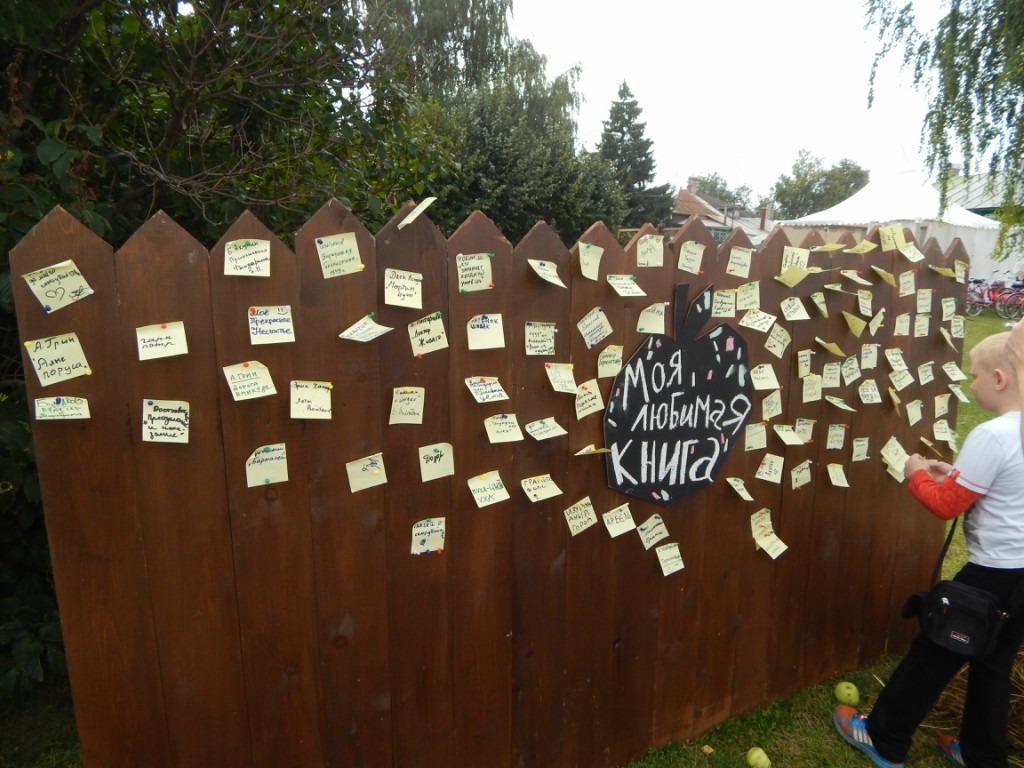
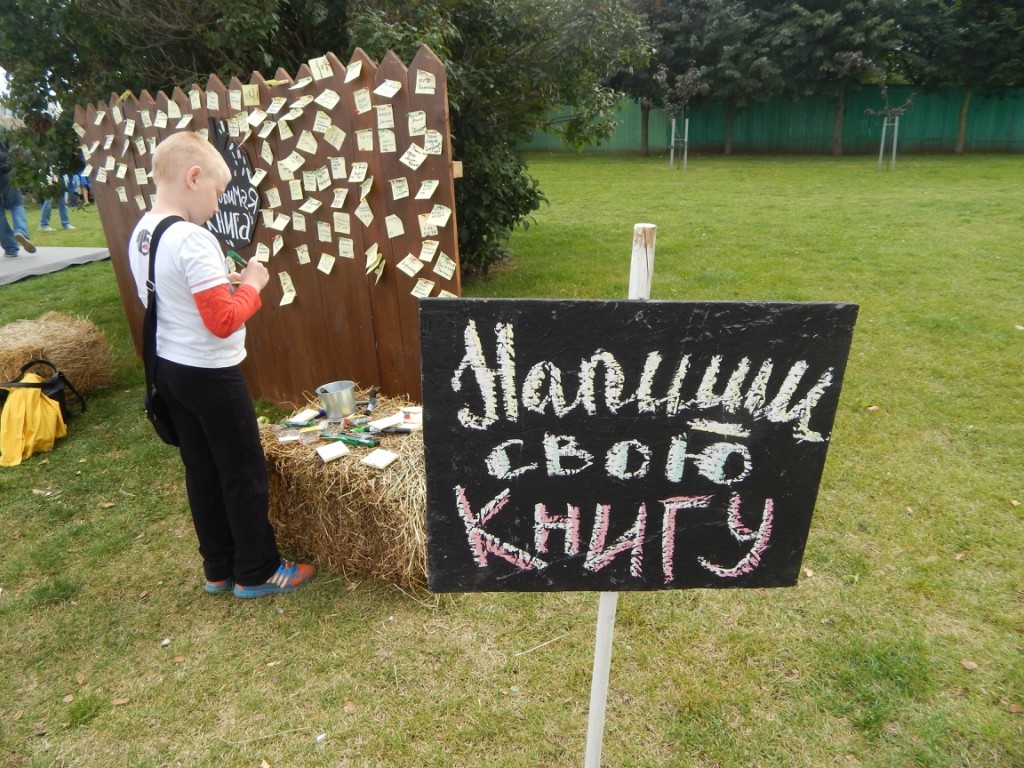


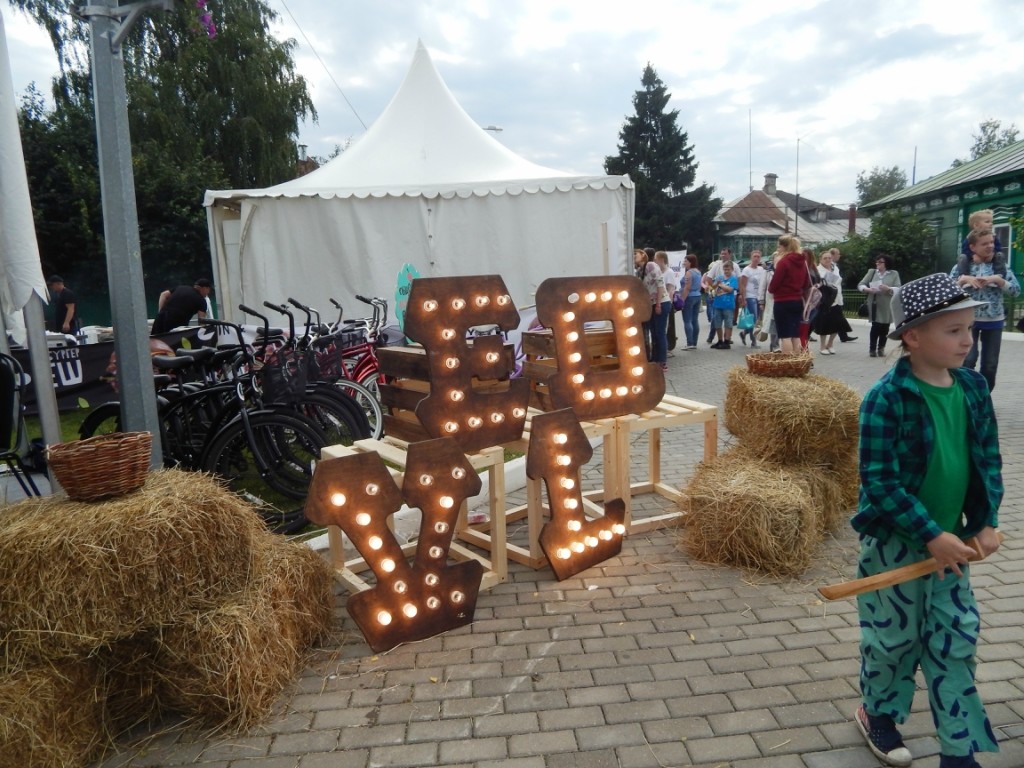
That's the bull's eye. One thing. Bad this year with apples.

The Society of Free Walkers has prepared a new walking route “Walls and Towers” for the guests of the festival. It began with Dish, and ended in Moskvoretsky Lane
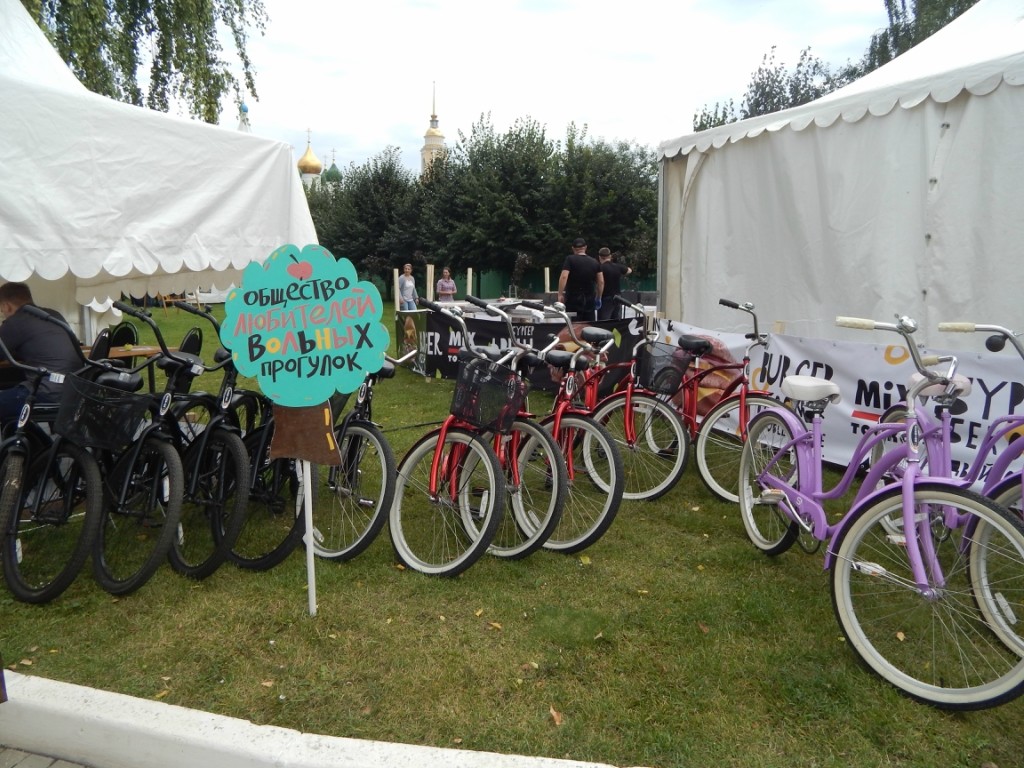
Visitors passing by the white tents were attracted by unusual flowing music. It turned out that such an unusual, but at the same time very melodic sound gives a tool called happy drama, glucophone or drum of happiness. He was represented to the attention of visitors by Kolomian Rinat Nurgaliyev. He said that the manufacture of the drum of happiness began three months ago. The instrument is intuitive, gives a calm, soothing sound. It is set up so that anyone can feel like a performer, extracting charming music from him. The peculiar carbon steel drum with cut petals is adjusted once and for all. Moreover, the thickness of the sound depends on the thickness of the metal.

According to R. Nurgaliyev, happy dramas appeared in America about ten years ago and have already gained popularity all over the world, including in Russia. On the "Antonov apples" everyone could try to play on the glucophone.
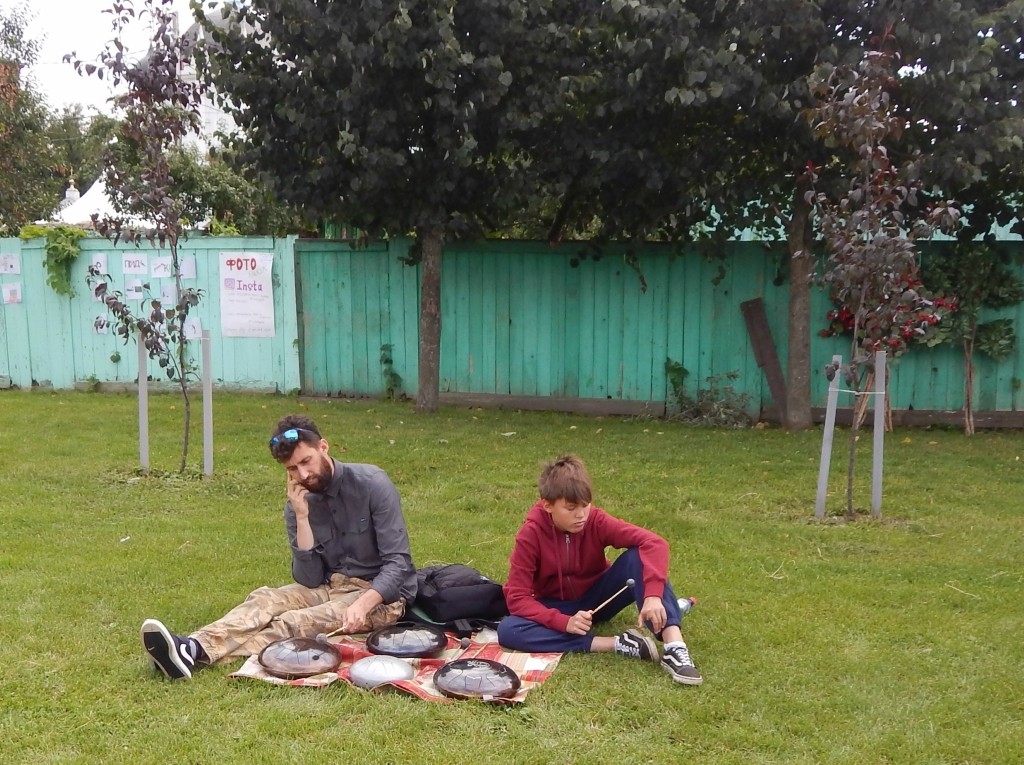
An apple city is being built here. Anyone can stick the plates - quarters on an apple.
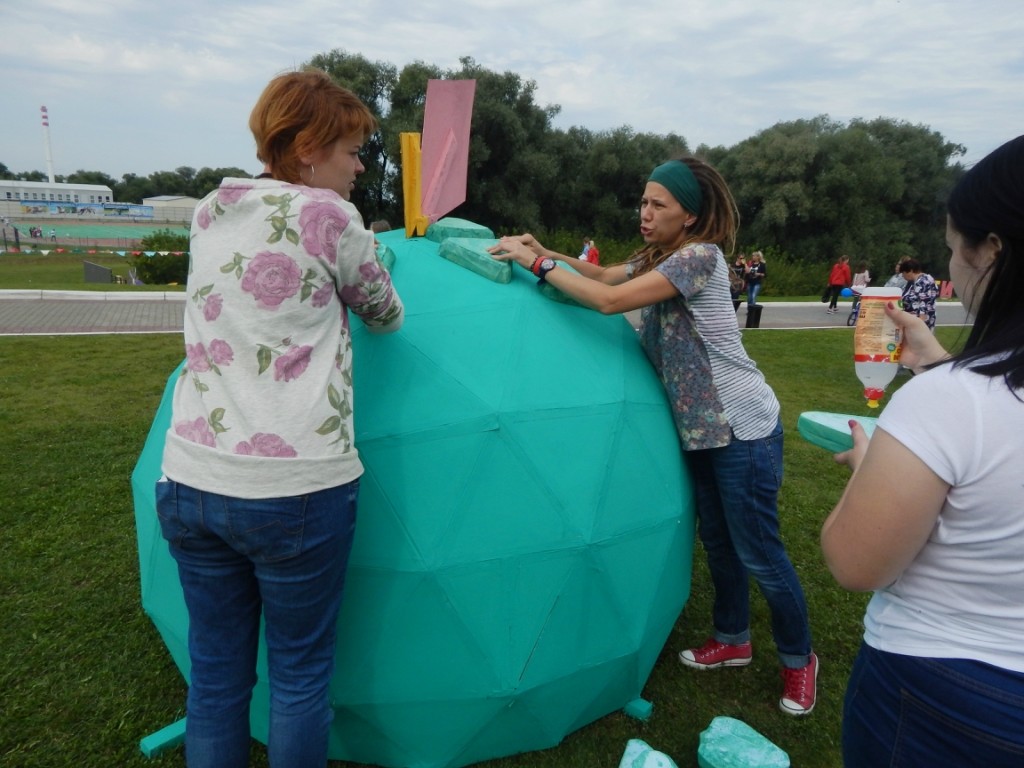
The Cossack Choir pleases the audience with spontaneous songs.
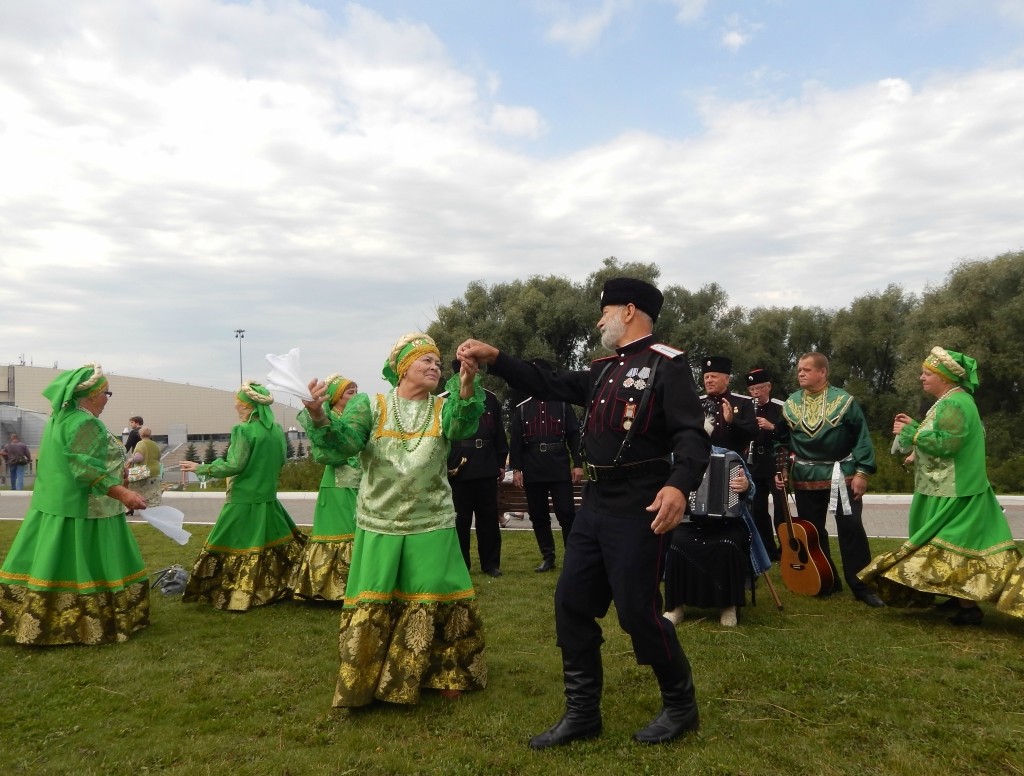
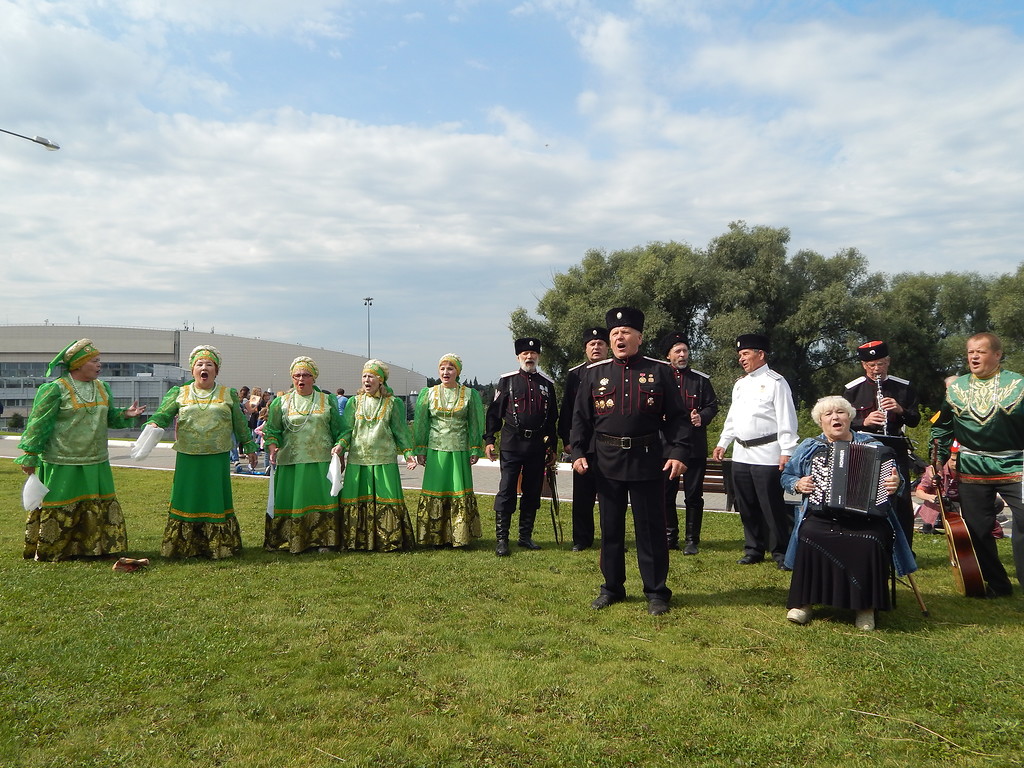
Kolomentsy and guests of the city were able to communicate live with famous and not very literary men. But nevertheless, the bookworms waited most of all for a meeting with writers Lyudmila Ulitskaya and Narine Abgaryan. The presenter of all literary meetings was a journalist, radio and TV presenter, director Fyokla Tolstaya.
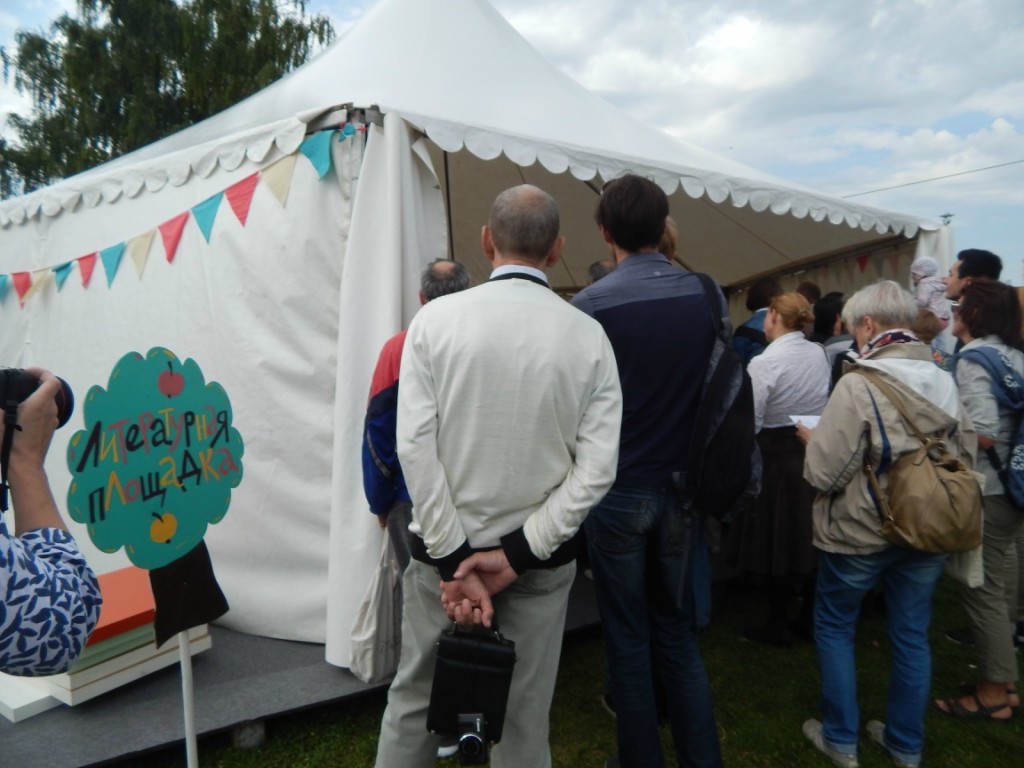
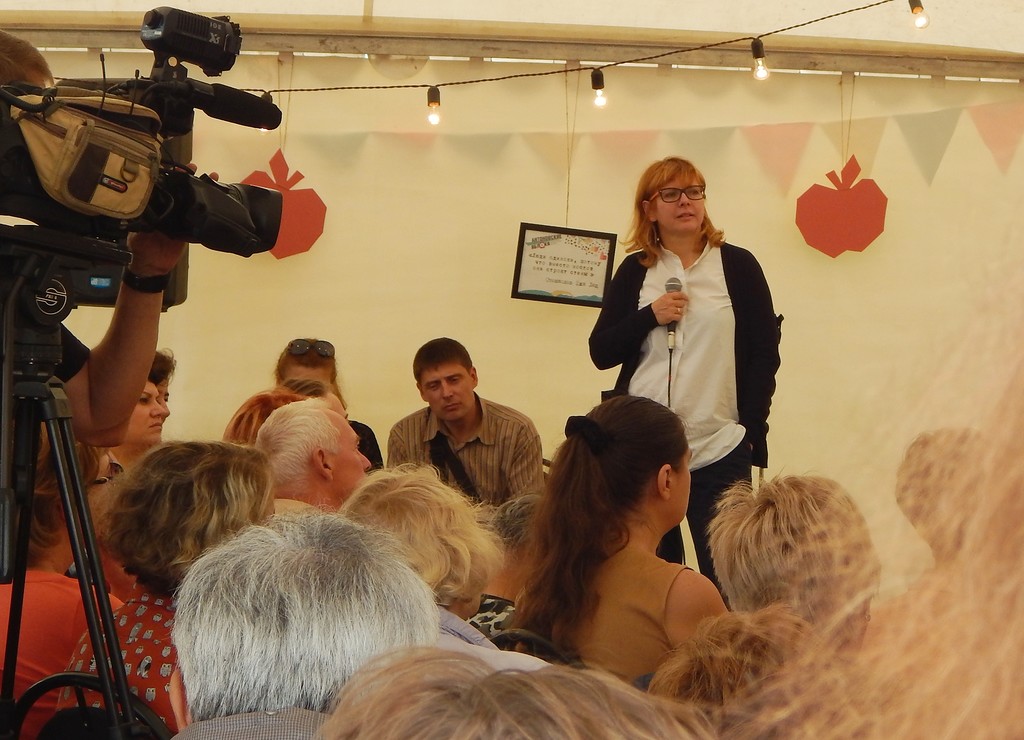

On the site of the Literary Pavilion - one of the most anticipated meetings of the festival - the performance of Lyudmila Ulitskaya, a writer and screenwriter, author of the novels "The Case of Kukotsky" and "Daniel Stein - Translator". In the books of Ulitskaya lives the history of the XX century. At a meeting with readers in Kolomna, the writer answered questions and read the story “Gudauta Pears”.
On September 2, 2017, the sixth annual apple-book festival ANTONIAN APPLES will be held in Kolomna near Moscow.Special guest of the festival - a writer, winner of the literary award "Yasnaya Polyana"- Narine Abgaryan.
Kolomna will greet guests with the smells of Antonov apples, a fresh literary program, new books, tastes of seasonal farm food, ride along the “time routes” in the Old Town, and send to distant “apple journeys” outside Kolomna.
LITERATURE PROGRAM The festival will, as before, be accompanied by creative meetings. On the children's literature "for those over 10," will tell the writer Yuri Nechiporenko, author of the book "Pushkin" (Octopus Publishing House). Sasha Dugdale (United Kingdom) will hold a translation workshop, coupled with the reading of her poem. And, finally, the personal experience of motherhood will tellNadia Papudoglo- book author " # tyzhemat. Maternity by the rules and without"(Publishing house" Scooter ").
15 :00 - creative meeting with the writer, the winner of the literary award "Yasnaya Polyana" - Narine Abgaryan.
Moderator of literary meetings - journalist, radio and TV presenter, director Thekla Thick.
ENGLISH PAVILION at the Intercession Church will receive those who want to read and listen to new items of English literature. The structure of the readings will remain the same. In the morning - literature for the smallest. Closer to noon - for those who are older, and at five o'clock - the traditional “tea party with needlework” by Miss Marple. When it starts to get dark, there will come a special time of reading in the dark - the most suitable time for stories from which the blood runs cold.
A game-travel Literary Odyssey will cover a half century of Russian and Soviet literature, many countries and cities. Traveling with the authors of well-known and not very well-known works of our suitcases, you will compile a map of Literary Odyssey for yourself - a list of pleasant and useful sofa reading.
For the first time this year the festival opens an extensiveTHEATER PROGRAM with children's and adult performances under the name "Art Communal".Beautiful views and historical interiors of the city will turn into a great theatrical scenery for the productions of modern directors. The city as a space of common life, a common communal space will be enriched with vitamins of creativity and theatrical play, so necessary for children and adults.
New format of live communication and treats, we will try on CITY DINNER.
City lunch- this is the time when everyone brings something personally cookedfrom fruits grown in their own gardens and at a large table, people treat each other and discuss their concerns regarding the practice of organic gardening and horticulture.
On the cinema music evening platformMUSICAL BRIDGE music winners of international competitionsDmitry German (violin), Oleg Bugaev (cello), Yevgeny Varavko (clarinet) and Maria Vlasov (accordion) will perform the famous melodies of Sergei Prokofiev, Dmitry Shostakovich, Isaac Dunaevsky, Aram Khachaturian, Georgy Sviridov, Isaac, Shvartsa and Astra Khvartovsky, Aram Khachaturian, Georgy Sviridov, Isaac Dunayevsky, Georgy Sviridov, Dmitriy Shostakovich, Isaac Dunayevsky Michel Legrand, Enrique Morricone, Francis Ley and John Williams from legendary Soviet, American, Italian and French films.
And at the end of the festival, the street premiere of the best films created in Kolomna in the framework of the International Short Film Laboratory will please the audience."KINOLAB Kolomna" .
The new venue for the Antonov Apples festival is the Blyudechko Square, located on the site where the walls of the Kolomna Kremlin used to stand, not far from the confluence of the Kolomenka River into the Moscow River.
In place of the square in ancient times were the city fortifications, the first in the history of Kolomna. Historians suggest that it was at this place that the first settlement once emerged (which later turned into a city), and from here began the development of Kolomna.
It is the place that inspires the main theme of the festival “Antonov apples” ’2017. We will talk about BRIDGES AND WALLS. What binds us, and what - divides, in the universal sense? Borders are everywhere. Culture creates boundaries. Any product of artistic activity is an organization of chaos. To build boundaries, to separate one from another - the natural need of human perception. But borders do not always interfere. Would not the picture be limited to the frame, could we separate art from everyday life?
On the other hand, bridges are what connects and connects. The bridge embodies collective energy, transitional states, creatively productive and paradoxical.
About BRIDGES AND WALLS The festival invites to speak in the language of art, literature, music!
The next day, September 3
as part of the festival program we will go to“Apple Journey” - the family estate of Lev Nikolayevich Tolstoy “Yasnaya Polyana” and the Darovoye family estate of Dostoevsky (50 km from Kolomna).
Antonov apples. Read with taste!
The world celebrates International Day for Premature Babies.
Source: calend.ru
World Philosophy Day. The idea of establishing World Philosophy Day is to find a common platform for discussing global sociocultural transformations taking place in society, to introduce people to the philosophical legacy, to open up the sphere of everyday thinking to new ideas and stimulate public debates of thinkers and civil society on the challenges that society faces today. . Many thinkers have argued that the essence of philosophy is surprise. Indeed, philosophy is born from the natural aspiration of human beings to be interested in themselves and the world in which they live. As a reflection and love of wisdom, philosophy teaches us to think about thoughts, explore fundamental truths, verify premises and build our own conclusions.
Source: calend.ru
The first sound telecast took place in the USSR. It lasted 25 minutes and was a pop concert. Famous artist I.M. Moskvin read the story of A.P. Chekhov's "Malefactor", then the singer and ballet couple performed.
Source: calend.ru
A lively 22-year-old journalist Nellie Bly (real name Elizabeth Cochrane, 1864–1922), a reporter for the New York World New York newspaper, set out to break the record of Jules Verne’s hero Around the World in 80 Days. Even to repeat such a fantastic achievement at that time seemed an unheard of audacity, but Nellie Bly surpassed him, having traveled the Earth around in 72 days 6 hours 10 minutes 11 seconds.
Source: calend.ru
A very good tradition for many countries has become the annual celebration on November 13 of World Kindness Day. To do good deeds is incredibly simple, goodness is not measured by money, sometimes it does not take much time and effort, the main thing is to start. Even just a kind smile to a stranger is already capable of performing miracles, including for the person himself, who does this Good. After all, besides the fact that good deeds raise everyone's mood, they also have the best effect on their well-being, they increase their vitality.
Source: calend.ru
Several years ago, another ecological holiday appeared in Russia - Sinichkin Day. It was created at the initiative of the Union of Birds of Russia and is celebrated on November 12. On this day, residents of different settlements of the country are preparing to meet the "winter guests" - birds that stay for the winter in our area: tits, goldfinches, bullfinches, jays, tapas, waxwings. People prepare top dressing for them, including “sinichkiny delicacies”: unsalted lard, unroasted pumpkin, sunflower or peanut sunflower seeds, make and hang the feeders.

